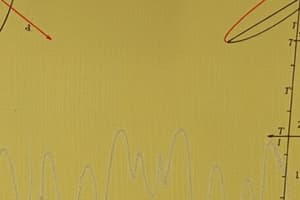Podcast
Questions and Answers
What is the period of the function y = 3 sin(x)?
What is the period of the function y = 3 sin(x)?
2π
What is the amplitude of the function y = 3 sin(x)?
What is the amplitude of the function y = 3 sin(x)?
3
What is the phase shift of the function y = 3 sin(x)?
What is the phase shift of the function y = 3 sin(x)?
0
What is the vertical shift of the function y = 3 sin(x)?
What is the vertical shift of the function y = 3 sin(x)?
What is the period of the function y = -2cos(x)?
What is the period of the function y = -2cos(x)?
What is the period of the function y = cos(x - π/2)?
What is the period of the function y = cos(x - π/2)?
What is the amplitude of the function y = cos(x - π/2)?
What is the amplitude of the function y = cos(x - π/2)?
What is the phase shift of the function y = cos(x - π/2)?
What is the phase shift of the function y = cos(x - π/2)?
What is the vertical shift of the function y = cos(x - π/2)?
What is the vertical shift of the function y = cos(x - π/2)?
What is the period of the function y = -sin(x + π/3)?
What is the period of the function y = -sin(x + π/3)?
What is the amplitude of the function y = -sin(x + π/3)?
What is the amplitude of the function y = -sin(x + π/3)?
What is the phase shift of the function y = -sin(x + π/3)?
What is the phase shift of the function y = -sin(x + π/3)?
What is the vertical shift of the function y = -sin(x + π/3)?
What is the vertical shift of the function y = -sin(x + π/3)?
What is the period of the function y = (1/3)cos(x/2 + π/3)?
What is the period of the function y = (1/3)cos(x/2 + π/3)?
What is the amplitude of the function y = (1/3)cos(x/2 + π/3)?
What is the amplitude of the function y = (1/3)cos(x/2 + π/3)?
What is the phase shift of the function y = (1/3)cos(x/2 + π/3)
What is the phase shift of the function y = (1/3)cos(x/2 + π/3)
What is the vertical shift of the function y = (1/3)cos(x/2 + π/3)?
What is the vertical shift of the function y = (1/3)cos(x/2 + π/3)?
What is the period of the function y = cos(3x - 2π) + 4?
What is the period of the function y = cos(3x - 2π) + 4?
What is the amplitude of the function y = cos(3x - 2π) + 4?
What is the amplitude of the function y = cos(3x - 2π) + 4?
What is the phase shift of the function y = cos(3x - 2π) + 4?
What is the phase shift of the function y = cos(3x - 2π) + 4?
What is the vertical shift of the function y = cos(3x - 2π) + 4?
What is the vertical shift of the function y = cos(3x - 2π) + 4?
What is the period of the function y = 2tan(x/4) - 3?
What is the period of the function y = 2tan(x/4) - 3?
What is the period of the function y = (1/3)tan(-2x - π) + 1 ?
What is the period of the function y = (1/3)tan(-2x - π) + 1 ?
What is the period of the function y = csc(x - π/4) - 2?
What is the period of the function y = csc(x - π/4) - 2?
What is the period of the function y = (1/3)cot(2x + 3π/2) + 1?
What is the period of the function y = (1/3)cot(2x + 3π/2) + 1?
Flashcards
Period of a trigonometric function
Period of a trigonometric function
The distance between consecutive peaks or troughs on a graph of a periodic function.
Amplitude of a trigonometric function
Amplitude of a trigonometric function
The maximum displacement of a periodic function from its equilibrium position. It is half the difference between the maximum and minimum values.
Phase Shift of a trigonometric function
Phase Shift of a trigonometric function
The horizontal shift of a periodic function from its standard position.
Vertical Shift of a trigonometric function
Vertical Shift of a trigonometric function
Signup and view all the flashcards
Period of sin(x) and cos(x)
Period of sin(x) and cos(x)
Signup and view all the flashcards
Amplitude of sin(x) and cos(x)
Amplitude of sin(x) and cos(x)
Signup and view all the flashcards
Phase Shift of sin(x) and cos(x)
Phase Shift of sin(x) and cos(x)
Signup and view all the flashcards
Vertical Shift of sin(x) and cos(x)
Vertical Shift of sin(x) and cos(x)
Signup and view all the flashcards
Period of tan(x)
Period of tan(x)
Signup and view all the flashcards
Period of sec(x) and csc(x)
Period of sec(x) and csc(x)
Signup and view all the flashcards
Period of cot(x)
Period of cot(x)
Signup and view all the flashcards
General form of sine and cosine functions
General form of sine and cosine functions
Signup and view all the flashcards
Reflection across the x-axis in trigonometric functions
Reflection across the x-axis in trigonometric functions
Signup and view all the flashcards
Period change in trigonometric functions
Period change in trigonometric functions
Signup and view all the flashcards
Amplitude change in trigonometric functions
Amplitude change in trigonometric functions
Signup and view all the flashcards
Phase shift change in trigonometric functions
Phase shift change in trigonometric functions
Signup and view all the flashcards
Vertical shift change in trigonometric functions
Vertical shift change in trigonometric functions
Signup and view all the flashcards
General form of tangent function
General form of tangent function
Signup and view all the flashcards
General form of secant and cosecant functions
General form of secant and cosecant functions
Signup and view all the flashcards
General form of cotangent function
General form of cotangent function
Signup and view all the flashcards
Even and odd functions in trigonometry
Even and odd functions in trigonometry
Signup and view all the flashcards
Even and odd functions in trigonometry
Even and odd functions in trigonometry
Signup and view all the flashcards
Periodic function
Periodic function
Signup and view all the flashcards
Sine and cosine ratios
Sine and cosine ratios
Signup and view all the flashcards
Tangent ratio
Tangent ratio
Signup and view all the flashcards
Secant function
Secant function
Signup and view all the flashcards
Cosecant function
Cosecant function
Signup and view all the flashcards
Cotangent function
Cotangent function
Signup and view all the flashcards
Graphs of secant and cosecant
Graphs of secant and cosecant
Signup and view all the flashcards
Graph of cotangent
Graph of cotangent
Signup and view all the flashcards
Study Notes
Graphing Trigonometric Functions
- Worksheet 15 Key provides examples of graphing trigonometric functions with different transformations.
- Each example demonstrates a specific trigonometric function (sine, cosine, tangent, secant, cosecant, cotangent) with variations in amplitude, period, phase shift, and vertical shift.
- The transformations affect the graph's shape and position.
Function Examples
-
y = 3sin(x):
- Period: 2π
- Amplitude: 3
- Phase Shift: 0
- Vertical Shift: 0
-
y = sin(3x):
- Period: 2π/3
- Amplitude: 1
- Phase Shift: 0
- Vertical Shift: 0
-
y = -2cos(x):
- Period: 2π
- Amplitude: 2
- Phase Shift: 0
- Vertical Shift: 0
-
y = cos(x - π/2):
- Period: 2π
- Amplitude: 1
- Phase Shift: π/2
- Vertical Shift: 0
-
y = -sin(x) + (x + π/3):
- Period: 2π
- Amplitude: 1
- Phase Shift: -π/3
- Vertical Shift: 0
-
y = sin(2x - π):
- Period: π
- Amplitude: 1
- Phase Shift: π/2
- Vertical Shift: 0
-
y = cos(x/3):
- Period: 8π
- Amplitude: 1
- Phase Shift: 0
- Vertical Shift: 0
-
y = cos(3x − 2π) + 4:
- Period: 2π/3
- Amplitude: 1
- Phase Shift: 2π/3
- Vertical Shift: 4
-
y = sin(x + 1) - 2 -Amplitude =1 -Period =2π -Phase Shift = -1
- Vertical Shift=-2
-
Additional examples include variations of tangent, cotangent, secant, and cosecant functions with similar transformations.
Graphing Strategy
- Graphing strategies mention showing several cycles to illustrate phase shifts; finding parameters like period and amplitude by referring to the base function.
Studying That Suits You
Use AI to generate personalized quizzes and flashcards to suit your learning preferences.




